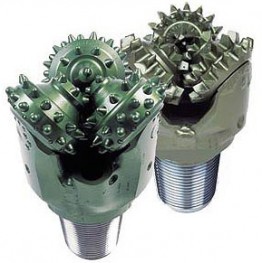Drill Bit
Tricone Bit
![]() IADC CODE REFERENCE
IADC CODE REFERENCE
1 1 1 C
First Digit:
1, 2, and 3 designate Steel Tooth Bits with 1 for soft, 2 for medium and 3 for hard formations.
4, 5, 6, 7, and 8 designate Tungsten Carbide Insert Bits for varying formation hardness with 4 being the softest and 8 the hardest.
1 1 1 C
Second Digit:
1, 2, 3, and 4 help further breakdown the formation with 1 being the softest and 4 the hardest.
4 Primary Types of Bearing Designs
- Standard Open Bearing Roller Bit
3rd digit will end with 1 - Air Bearing Roller Bit
3rd digit will end with 2 or 3 - Sealed Bearing Roller Bit
3rd digit will end with 4 or 5 - Journal Bearing Roller Bit
3rd digit will end with 6 or 7
1 1 1 C
Third Digit:
This digit will classify the bit according to bearing/seal type and special gauge wear protection as follows:
1.Standard open bearing roller bit
2.Standard open bearing bit for air drilling only
3.Standard open bearing bit with gauge protection which is defined as carbide inserts in the heel of the cone.
4.Roller sealed bearing bit
5.Roller sealed bearing bit with carbide inserts in the heel of the cone.
6.Journal sealed bearing bit
7.Journal sealed bearing bit with carbide inserts in the heel of the cone.
1 1 1 C
Fourth Digit/Additional Letter:
A - Air application
B - Special Bearing Seal
C - Center Jet
D - Deviation control
E - Extended Jets
G - Extra gauge protection
H - Horizontal Application
J - Jet Deflection
L - Lug Pads
M - Motor Application
R - Reinforced welds
S - Standard Tooth Bit
T - Two Cone Bits
W - Enhanced Cutting Structure
X - Chisel Insert
Y - Conical Insert
Z - Other insert shape
| Formation | Used in | PSI | RPM |
| Soft | shales, clays, red beds, salts, soft limestone and unconsolidated sands |
3000 – 6000 lbs of bit diameter | 120 – 90 reduce weight as RPM Increases |
| Soft to Medium | firm shale, anhydrite, salts, soft limestone and unconsolidated sands |
3500 – 6000 lbs of bit diameter | 100 - 60 reduce weight as RPM Increases |
| Medium | hard shales, sandstones, and limestones | 4000 – 8000 lbs. of bit diameter | 100 – 40 reduce weight as RPM Increases |
| Hard | hard sands, cherty limestone, dolomite, chert | 4500 –8000 lbs. of bit diameter | 80 – 45 reduce weight as RPM Increases |
| Very Hard | chert, quartzite, pyrite, granite, and hard sandstone | 6000 – 8000 lbs of bit diameter | 70 – 50 reduce weight as RPM Increases |
PDC

IADC Reference Codes For PDC Bits
Uses 4 characters to classify the bit.
- body material
- cutter density
- cutter size or type
- profile
M 1 1 1
First Character:
Denotes the body material
- M for Matrix
- S for Steel
M 1 1 1
Second Character:
Stands for the amount of ½ in. cutters
- Ranges 1 to 4 in PDC bits
- 1 = 30 or fewer ½ in. cutters
- 2 = 30 to 40 ½ in. cutters
- 3 = 40 to 50 ½ in. cutters
- 4 = 50 or more ½ in. cutters
M 1 1 1
Third Character:
Ranges from 1-4 and represents the size of
the PDC cutter on the bit
- 1 = cutters larger than 1 in.
- 2 = cutters from 9/16 in. to 1 in.
- 3 = cutters of 1/2 in.
- 4 = cutters of 5/16 in.
M 1 1 1
Fourth Character
Ranges 1 to 4 and gives as idea of basic appearance
of and body style the bit, based on the overall
length of the cutting face of the bit.
- 1 = fishtail PDC Bit
- 2 = short bit profile
- 3 = medium bit profile
- 4 = long bit profile


